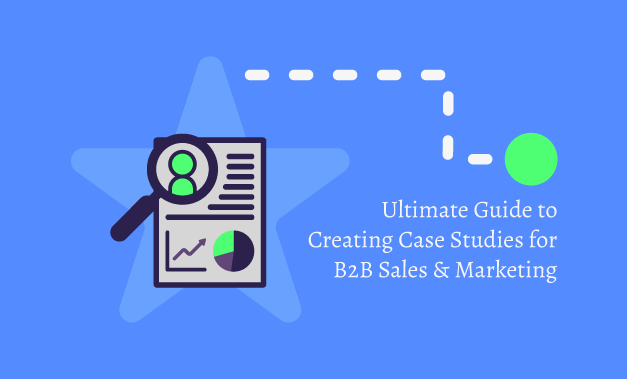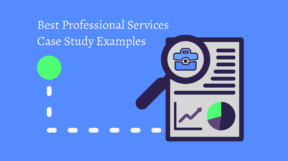Intro
Interested in creating Case Studies to use for your B2B sales efforts and marketing campaigns but don’t know where to start? This ultimate guide has you covered! This article points you in the right direction when it comes to the steps of creating Case Studies of your own, including how to schedule and prepare for interviews as well as develop and finalize your first draft.
What are Case Studies, and Why Should I Create Them?
Before you can create great Case Studies, you need to know the purpose they serve. Most of our blog posts define the term, as we can’t emphasize the importance of Case Studies enough.
In short, a Case Study is an overview of how your business has helped a real-life client. It’s an expanded, more sophisticated version of a Success Story that provides more context about your offering. It explains what issues the client had before you stepped in and how much the client’s business transformed once your product or service was in place.
Case Studies are extremely useful in B2B sales and marketing. They build confidence in your brand, as they serve as proof that your product or service works as it should and has resulted in satisfied customers.
However, high-quality Case Studies aren’t easy to create; they can take a significant amount of time, resources, and organizational skills. Furthermore, the creation process can go belly-up if a client doesn’t want to participate or if the right questions aren’t asked or the inappropriate tools are used. This is why many businesses rely on a third-party company like SuccessKit to create their Case Studies.
But you don’t find that daunting, we can tell! You’ve got a DIY spirit and the availability, tools, and know-how to take this project on yourself; you just need to know the steps. This brings us to our next section…
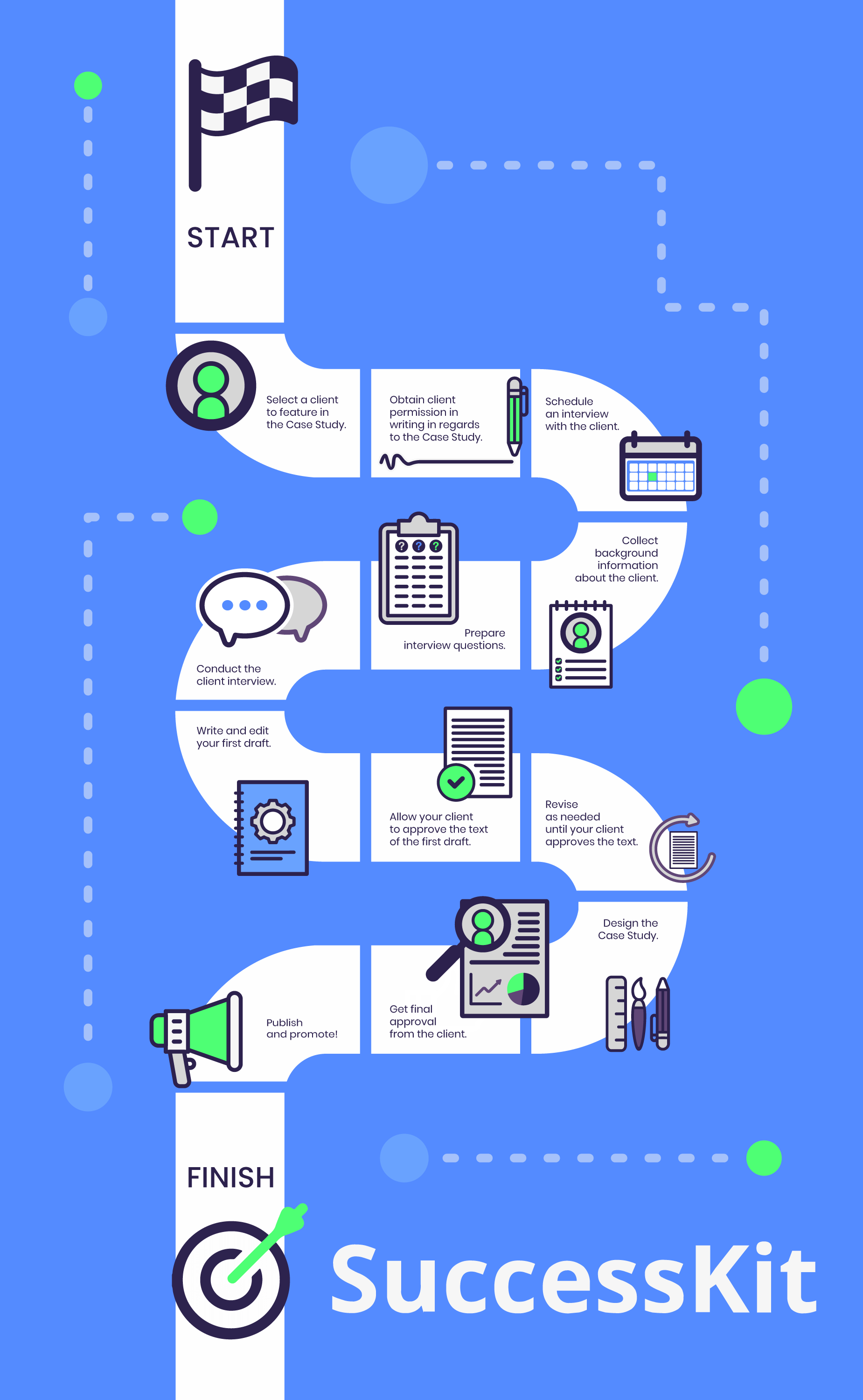
How Do I Go About Creating Case Studies?
Here’s a bare-bones overview of the steps you should follow when creating Case Studies:
- Select a client to feature in the Case Study.
- Obtain client permission in writing in regards to the Case Study.
- Schedule an interview with the client.
- Collect background information about the client.
- Prepare interview questions.
- Conduct the client interview.
- Write and edit your first draft.
- Allow your client to approve the text of the first draft.
- Revise as needed until your client approves the text.
- Design the Case Study.
- Get final approval from the client.
- Publish and promote!
Need more details? Aspects of each step are explored in more depth throughout this post—just find your burning question below.
What Makes for a Successful Case Study?
Now that you know what a Case Study is and the steps to create one, here’s how to identify one that’s successful.
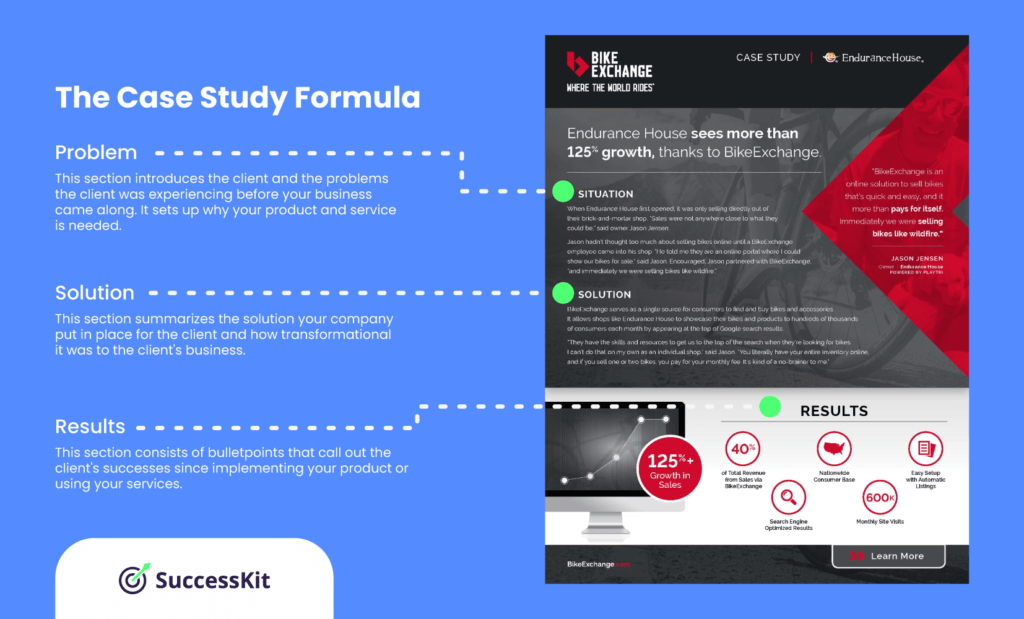
Structured Format
A successful Case Study follows a certain formula, namely the following:
- The Problem (or Situation) section introduces the client and the problems the client was experiencing before your business came along. It sets up why your product and service is needed.
- The Solution section summarizes the solution your company put in place for the client and how transformational it was to the client’s business.
- The Results (or Benefits) section consists of bulletpoints that call out the client’s successes since implementing your product or using your services.
By following this formula, the Case Study can’t help but tell the complete story—from start to finish.
Well-Written Content
A Case Study should not only be informative—it should also be organized and entertaining so that it compels prospects to keep reading. Don’t hesitate to hire a writer to ensure you wind up with a well-written product that flows logically from point to point. An editor is also crucial when it comes to polishing the work. Remember: You’re going to use this Case Study to generate more business for yourself, so it should be professional.
High-Quality Design
The design of a Case Study is going to be the very first thing a prospect notices about it, so it’s worth investing in. After all, this will be a tool used by both your sales and marketing teams. It’s going to be used a lot to attract new clients and it should look fantastic.
Make sure you have the right software (and people who know how to use it) in order to create an eye-catching, cohesive Case Study template. Consider hiring a designer experienced in creating layouts if you need to. This individual will also be able to effectively apply your branding and incorporate graphics, icons, charts, and other interesting and relevant visual elements to the document.
Successful Clients
Make sure the showcased client—the subject of your Case Study—is one who has reason to be truly enthusiastic about your business. When selecting a Case Study subject, consult with your sales or account management teams to learn which clients have enjoyed increased revenue, site traffic, and so on thanks to your company’s product or service. Clients who’ve seen real results are more likely to agree to feature in your Case Study and speak highly of your company.
Examples of High-Quality Case Studies
Take a look at our library of Case Studies to get an idea of what yours should look and read like. Note that each template is tailored specifically to each client, and they all follow the Problem > Solution > Results formula.
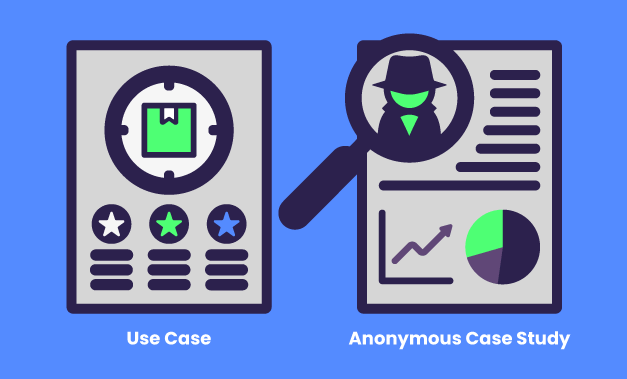
What If My Client Won’t Participate in a Case Study?
You absolutely must get your clients’ permission to feature them in your Case Studies; their participation, names, logos, images, and quotes bolster any claims made. However, clients tend to grant different levels of approval varying from full and partial participation to no participation at all. Some clients will provide you with unrestricted access to their brand assets, while others may agree to be interviewed but refuse to let you publish the Case Study. It’s also possible that clients may grant full permission only after seeing a draft.
You can increase the likelihood that your clients will grant permission by having positive relationships with them before you start and being transparent about the Case Study process. But whatever combination of approvals and permissions your clients provide, you need to fully understand them—and ensure they’re fully documented—before doing any work on the Case Study. Doing this will avoid any costly mistakes or wasted time—or even legal issues.
If your client can’t agree to a Case Study, that’s not a problem. You can opt to use the information you do have about the client and your offering to create a Use Case or an Anonymous Case Study.
A Use Case features your company’s product or service and explains how it might be used in a real-world scenario. It focuses purely on your offering and doesn’t mention a specific client.
Meanwhile, an Anonymous Case Study is just what it sounds like: a Case Study about a client without any identifying information. This type of Case Study can be created with or without the client’s full participation. If you have full participation, you’ll refer to the subjects of the Case Study by their job titles instead of their name. You’ll also use descriptive terms to refer to the client’s business (e.g., “a farm-equipment manufacturer in New Jersey”). If you have no client participation, you’ll use quotes and anecdotes from members of your in-house team who are familiar with the client.

How Do I Conduct a Case Study Interview?
Before the Interview
If your client agrees to be interviewed for the Case Study, it’s time to gather and create some key information in preparation for the interview.
Background Details About the Client
In order to ask insightful questions, you’re going to have to do a little research first. Ensure you have a full understanding of the value you’ve brought to your client’s business. Collect statistics and figures that emphasize how your client’s business improved since your involvement. Talk to the members of your in-house team who’ve worked with your client to get the inside scoop about what your client is most excited or concerned about.
Interview Questions
Develop some questions that concern the three key areas of the Case Study (i.e., the Problem, Solution, and Results). The following are examples of each:
- “What was your company like before working with us?” (Problem)
- “In what ways does using our product change your day-to-day operations?” (Solution)
- “How does our product help you to grow as a company?” (Results)
Use the background information you collected to help craft these questions. You’ll have already learned what aspects of your offering that your client is most excited about. Use that information to guide your questioning to get some enthusiastic responses.
During the Interview
Start the Case Study interview by setting expectations. Define the purpose of the interview and state how long it will take. Remind the client that the interview is being recorded and confirm permissions given (or not given) before getting underway.
Then, conduct the interview in the same order that the Case Study will have—again, the Problem, Solution, and Results.
Questions About the Problem
When asking questions about the problem, push beyond surface-level answers like “Our manual data-entry process was a pain.” Learn the full extent to which the problem impacted the client’s profits, customers, growth, and so on. (For example, “Because our employees had to spend so much time manually entering data, they didn’t have time to give our customers quality service and support.”)
Questions About the Solution
When asking about the solution, connect the dots between your offering and your client’s problem. For example, “How have your day-to-day operations changed now that our software has automated your previously manual data-entry process?”
Questions About the Results
If you collected key metrics about the client, it’s time to bring them up when talking about the results. (For instance, “How did our software save your employees two extra hours every day?”) If the client doesn’t have specific figures to share, go for qualitative results by asking opinion-based questions (“How has our software made your employees more efficient?”).

How Do I Write and Design a Case Study?
When the interviews conclude, it’s time to get into the actual creation of your Case Study. The blank page can be daunting, so to energize the process, copy and paste the transcript of your client interview into a word processing program. Whittle away any irrelevant conversation, and then organize the content into the three main sections. (Yep, Problem > Solution > Results come into play once again!)
Then, use this skeleton to actually write your Case Study. The story should flow logically. Avoid being redundant with quotes and facts—pick the very best phrasing and go with that. Make your client look good, especially if you’ve only received partial or restricted approval. (This increases the chances the client will grant full approval.)
If you get stuck, consult our free Case Study Template. It offers prompts and visual cues to provide you with enough inspiration and direction to produce an impactful piece of content.
Once you’ve written (and edited!) the Case Study, have your client review the text. You don’t want to go forward with the design phase without your client signing off on the text; the client may request substantial changes that will dramatically alter the design. Also, this creates an opportunity for the client to grant that highly desired full, unrestricted approval.
When the time comes to design your Case Study, aim to create a layout that’s attractive and easy to read. Clearly indicate the Problem/Solution/Results sections. Additionally, incorporate your company branding guidelines and visuals such as images, graphs, charts, icons, and so on.
Remember: If you’re really struggling with writing, editing, and/or designing your Case Study, bring in help from a third party. Hire someone with experience who knows what to do to create a high-quality, professional Case Study.
It’s time for the final round of client approvals once you’ve completed your Case Study design. The client shouldn’t have too many changes at this point. At most, the client may point out a typo, provide a new image, or request a quote revision. Furthermore, the client isn’t approving the design—that’s your company asset with your branding. This is a courtesy to the client (and yes, a last chance to get full permission if you haven’t yet received it). Your client invested time in helping you create this, so it stands to reason that the client should see how it turned out!

What Do I Do with My Case Studies?
Even the most brilliant Case Studies are no good if no one ever reads them. This section lists a few ideas for what you can do with your Case Studies once they’re finished.
The Sales Cycle
Case Studies can be effectively used in outbound sales prospecting. This is especially true if the prospect has a similar business and/or problem to the client featured in the Case Study. Members of the sales team should use the Case Study to craft tailored messaging to prospective clients.
Marketing Campaigns
A Case Study is a gold mine for a marketing campaign. Pieces of it can be used for so many different purposes. This includes ad and newsletter content, website features, and nurturing efforts.
Social Media Content
Social media is a great place to share your Case Studies. Craft your post so that it intrigues your target audience to the point where they can’t help but want to know more. Make it short, mysterious, and personal.
Conclusion
Creating Case Studies involves a significant amount of work. However, they’re worth the time, money, and energy to create because they’re tools you’ll use to grow your business.
If you need guidance with your Case Study projects, reach out to us at [email protected]. SuccessKit is here to help!
